|
|||
Update of the HUI and the TNXDavid Petch Bustling shoppers amidst packed shopping malls, bungled with parcels and bags draped over arms, causing more skin lines than a heroine addict. Panic-stricken parents' eyes quickly dashing left to right up and down, praying... hoping that one of their required gimmick Christmas items remain for their little ones... Tickle Me Elmo in the 1990's, Wii units and accessories for the 2000's... what will it be next year? Frozen turkeys of various sizes line the store freezer, ranging in size from Big Bird to a robin. Will it fit in the freezer... will we have too much and ohh, what kind of tofu treat can we prepare for the Vegans who will be at our table? Grizwald Christmas trees to Charlie Brown Christmas trees strewn across the lot, with the salesman offering tips about cutting the base of the tree and adding water to keep the tree from shedding needles to hagglers refusing to pay more for a Fir tree than the cheaper Scotch Pine. Christmas cards received from near and afar, with quick signatures inked out and mailed for those unexpected cards received by "lost addressed" friends. Family gatherings with the in-laws, where to go and what to bring... oh, we have the non-nuclear family to visit, with mom's long-time boyfriend and dad's new fling. The above is a mere representation of some of the stresses associated with Christmas time. For those who think it is a peaceful time, it can be, but it is less stressful if all of the planning and purchases are done beforehand. This thought ties into markets of late, with nearly everyone suffering from the sharp decline and panicking about what to do, last minute portfolio shufflings or stock additions. Analysis has been significantly examined and reexamined the past few months to make sure that all possible market outcomes are identified, with pattern failure and breakout points identified. Given the wheels have fallen off the global economic engine, analysis presented today suggests that the trend may take longer than many anticipate before we emerge as a whole on the other side of this economic malaise. It is important to realize that economic uncertainty for many companies increases the risk and associated analysis before considering any sort of investment in individual stocks. As such, playing ETF's containing a basket of stocks or based on a given commodity is the preferred route of investment for the majority of trades going forward. Analysis of the HUI and 10 Year US Treasury Index today will give an indication with respect to what lies ahead over the course of the next 5 trading days. AMEX Gold BUGS Index The lower 55 MA Bollinger band is at 117.74, up from last week's value of 108.23, suggestive a top is not too far off. Lower and upper Bollinger bands continue to contract, indicating the present consolidation is still underway. Full stochastics 1, 2 and 3 have the %K above the %D, with #1 just curling up after failing to fall beneath the %D (and even touch it for that matter). When the %K of stochastics #1 and #2 begin to curl down, it will indicate that a top has been put in place.  Moving averages are shown below in bearish alignment (200 day MA above the 155 day MA above the 50 day MA), with the 50 day MA acting as support at 215. The 38.2% retracement level at 265.7 has acted as resistance thus far, with any move above suggestive a move to 300 is in store over a very short period of time.  The weekly chart of the HUI is shown below, with lower Bollinger bands falling beneath the index, requiring the lower 34 and 55 MA BB's to curl up before indicating that a definitive top has been put in place. The upper 55 MA Bollinger band is at 607.13, down from last week's value of 607.5... this suggests a bottom of some form has been put in place and could last for 2-3 months before it begins to curl up again. Red lines on the right hand side represent Fibonacci price retracements of the move from 2002 until mid 2008. Blue lines on the right hand side represent Fibonacci price retracements of the decline from August until the recent October lows. Areas of line overlap form Fib clusters, which indicate important levels of support/resistance. Full stochastics 1, 2 and 3 are shown below in order of descent, with the %K above the %D in #1, but starting to curl up... should this follow through there is opportunity for a 3-4 month rally. Since full stochastics have been declining for one year, there is a good chance that a 4-6 month interim corrective bounce should form, given historical tendencies for having rallies being equivalent to at least half the time of the former decline. It is important to not that the %K seen in stochastics #2 and #3 are at levels not seen since late 2000. Such a degree oversold conditions suggest the initial 4-6 months of 2009 should be good to gold bugs. The trend could last longer, but profits should be taken after the present move concludes on the weekly time frame (some time beyond Q1 2009). 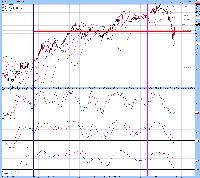 The short-term Elliott Wave count of the HUI is shown below, with the preferred count shown in colour and the alternate shown in grey. There is an equal probability for either pattern, but the price target reached during the present leg up will dictate which pattern is in play. Since the alternate count (grey) completed later, it makes sense for a higher upside price objective than the preferred count. The initial upside objective for the HUI remains 300 as mentioned last week. Dashed coloured and grey lines indicate the thought path of the HUI and have been following the pattern to a tee thus far (drawn in earlier last week). The HUI is either heading up in a B wave that will take much longer than wave A took to decline, or the move up is an (X) wave that must complete in an equivalent or lesser period of time that wave (W) took to form (3 ¾ months for the alternate count or 2 ¾ months for the preferred count). From a time perspective, if the move up was an (X) wave based upon the preferred count, there would only be one month left in the rally... or 3 months left based upon the alternate count. My thoughts are that a (B) wave of the decline may be forming, which could take anywhere from 6-8 months to form (maybe longer) before topping out. To cover all scenarios, the above are included to take into account how to trade the move based upon which pattern emerges correct. Those wishing to trade should consider taking profits when the HUI gets near 300, or there is upside exhaustion in the move. 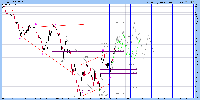 The mid-term Elliott Wave count of the HUI is shown below, with the preferred and alternate counts shown in colour and grey, respectively. The move of the HUI and gold is inversely related to the overall direction of the US dollar index. This is key for the trade and will be covered further tomorrow AM. 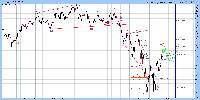 The 10 Year/2 Year US Treasury Index is shown below, with all lower Bollinger bands rising higher. With the ratio unexpectedly heading higher, all of the upper Bollinger bands are in a position to rise with the index. With a breakout against the former highs established in 2003, it appears that a classic cup and handle formation completed with the potential for an equivalent move to the upside underway which would likely end around 3.7-3.8. Full stochastics 1, 2 and 3 are shown below, with the %K above the %D in #1 and about to curl higher in #2. This creates the possibility for another 3-4 weeks of upside in the ratio before topping out. A rising ratio often indicates stock market weakness, so at some point in the not too distant future, this will trigger stock market weakness. 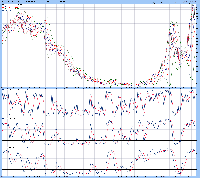 The long-term Elliott Wave count of the TNX is shown below. I have been tinkering all weekend with this chart and the best way to count this appears to be an expanding triangle. Wave [C] was longer than wave [A] and wave [E] is required to be the longest wave and as such, expect the TNX to head to at least 2-2.10 before bottoming... at a minimum. Wave [C] was nearly equivalent to wave [A] in time, which was 3 years... Wave [E] has been underway since July 2007, so there is at least another 18-20 months required before it bases. Translation: it is going to be at least until mid 2010 before the present period of declining interest rates finds a bottom. 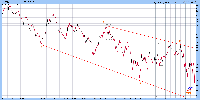 Dec 14, 2008 |
